Jupiter is the fifth planet from the Sun and by far the largest within our solar system. Some have described the solar system as consisting of the Sun, Jupiter, and assorted debris,[2] and others describe it as the solar system's vacuum cleaner, due to its immense gravity well. It, and the other gas giants Saturn, Uranus, and Neptune, are sometimes referred to as "Jovian planets." The Romans named the planet after the Roman god Jupiter (also called Jove). The astronomical symbol for the planet is a stylized representation of the god's lightning bolt (Unicode: ♃).
 |
|||||||
|---|---|---|---|---|---|---|---|
| Orbital characteristics (Epoch J2000) | |||||||
| Semi-major axis | 778,412,027 km 5.203 363 01 AU |
||||||
| Orbital circumference | 4.888 Tm 32.675 AU |
||||||
| Eccentricity | 0.048 392 66 | ||||||
| Perihelion | 740,742,598 km 4.951 558 43 AU |
||||||
| Aphelion | 816,081,455 km 5.455 167 59 AU |
||||||
| Orbital period | 4333.2867 d (11.86 a) |
||||||
| Synodic period | 398.88 d | ||||||
| Avg. Orbital Speed | 13.056 km/s | ||||||
| Max. Orbital Speed | 13.712 km/s | ||||||
| Min. Orbital Speed | 12.446 km/s | ||||||
| Inclination | 1.305 30° (6.09° to Sun's equator) |
||||||
| Longitude of the ascending node |
100.556 15° | ||||||
| Argument of the perihelion |
274.197 70° | ||||||
| Number of satellites | 63 | ||||||
| Physical characteristics | |||||||
| Equatorial diameter | 142,984 km [1] (11.209 Earths) |
||||||
| Polar diameter | 133,709 km (10.517 Earths) |
||||||
| Oblateness | 0.064 87 | ||||||
| Surface area | 6.14×1010 km2 (120.5 Earths) |
||||||
| Volume | 1.338×1015 km3 (1235.6 Earths) |
||||||
| Mass | 1.899×1027 kg (317.8 Earths) |
||||||
| Mean density | 1.326 g/cm3 | ||||||
| Equatorial gravity | 23.12 m/s2 (2.358 gee) |
||||||
| Escape velocity | 59.54 km/s | ||||||
| Rotation period | 0.413 538 021 d (9 h 55 min 29.685 s) 1 | ||||||
| Rotation velocity | 12.6 km/s = 45,300 km/h (at the equator) |
||||||
| Axial tilt | 3.13° | ||||||
| Right ascension of North pole |
268.05° (17 h 52 min 12 s) | ||||||
| Declination | 64.49° | ||||||
| Albedo | 0.52 | ||||||
| Surface temp. |
|
||||||
| Adjective | Jovian | ||||||
| Atmospheric characteristics | |||||||
| Atmospheric pressure | 70 kPa | ||||||
| Hydrogen | ~86% | ||||||
| Helium | ~14% | ||||||
| Methane | 0.1% | ||||||
| Water vapor | 0.1% | ||||||
| Ammonia | 0.02% | ||||||
| Ethane | 0.0002% | ||||||
| Phosphine | 0.0001% | ||||||
| Hydrogen sulfide | <0.00010% | ||||||
The Chinese, Korean, and Japanese cultures refer to the planet as the Wood Star, based on the Five Elements.
Overview
Jupiter has been known since ancient times and is visible to the naked eye in the night sky. In 1610, Galileo Galilei discovered the four largest moons of Jupiter using a telescope, the first observation of moons other than Earth's.
Jupiter is 2.5 times more massive than all the other planets combined, so massive that its barycenter with the Sun actually lies above the Sun's surface (1.068 solar radii from the Sun's center). It is 318 times more massive than Earth, with a diameter 11 times that of Earth, and with a volume 1300 times that of Earth. As impressive as it is, extrasolar planets have been discovered with much greater masses. There is no clear-cut definition of what distinguishes a large and massive planet such as Jupiter from a brown dwarf star, although the latter possesses rather specific spectral lines. Jupiter is thought to have about as large a diameter as a planet of its composition can; adding extra mass would result in further gravitational compression, in theory leading to stellar ignition. This has led some astronomers to term it a "failed star", although Jupiter would need to be about seventy times as massive to become a star.
Jupiter also has the fastest rotation rate of any planet within the solar system, making a complete revolution on its axis in slightly less than ten hours, which results in a flattening easily seen through an Earth-based amateur telescope. Its best known feature is probably the Great Red Spot, a storm larger than Earth. The planet is perpetually covered with a layer of clouds.
Jupiter is usually the fourth brightest object in the sky (after the Sun, the Moon and Venus; however at times Mars appears brighter than Jupiter, while at others Jupiter appears brighter than Venus). It has been known since ancient times. Galileo Galilei's discovery, in 1610, of Jupiter's four large moons Io, Europa, Ganymede and Callisto (now known as the Galilean moons) was the first discovery of a celestial motion not apparently centered on the Earth. It was a major point in favor of Copernicus' heliocentric theory of the motions of the planets; Galileo's outspoken support of the Copernican theory got him in trouble with the Inquisition.
Physical characteristics
Planetary composition
Jupiter is composed of a relatively small rocky core, surrounded by metallic hydrogen, surrounded by liquid hydrogen, which is surrounded by gaseous hydrogen. There is no clear boundary or surface between these different phases of hydrogen; the conditions blend smoothly from gas to liquid as one descends.
Atmosphere
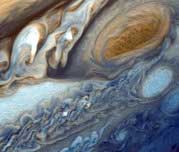
False color detail of Jupiter's atmosphere, imaged by Voyager 1, showing the Great Red Spot and a passing white oval.
Jupiter's atmosphere is composed of ~81% hydrogen and ~18% helium by number of atoms. The atmosphere is ~75%/24% by mass; with ~1% of the mass accounted for by other substances - the interior contains denser materials such that the distribution is ~71%/24%/5%. The atmosphere contains trace amounts of methane, water vapour, ammonia, and "rock". There are also traces of carbon, ethane, hydrogen sulfide, neon, oxygen, phosphine, and sulfur. The outermost layer of the atmosphere contains crystals of frozen ammonia.
This atmospheric composition is very close to the composition of the solar nebula. Saturn has a similar composition, but Uranus and Neptune have much less hydrogen and helium.
Jupiter's upper atmosphere undergoes differential rotation, an effect first noticed by Giovanni Cassini (1690). The rotation of Jupiter's polar atmosphere is ~5 minutes longer than that of the equatorial atmosphere. In addition, bands of clouds of different latitudes flow in opposing directions on the prevailing winds. The interactions of these conflicting circulation patterns cause storms and turbulence. Wind speeds of 600 km/h are not uncommon. A particularly violent storm, about three times Earth's diameter, is known as the Great Red Spot, and has persisted through more than three centuries of human observation.
The only spacecraft to have descended into Jupiter's atmosphere to take scientific measurements is the Galileo probe (see Galileo mission).
See also: Cloud pattern on Jupiter
Planetary rings
Jupiter has a faint planetary ring system composed of smoke-like dust particles knocked from its moons by meteor impacts. The main ring is made of dust from the satellites Adrastea and Metis. Two wide gossamer rings encircle the main ring, originating from Thebe and Amalthea. There is also an extremely tenuous and distant outer ring that circles Jupiter backwards. Its origin is uncertain, but this outer ring might be made of captured interplanetary dust.
See also: Rings of Jupiter.
Magnetosphere
Jupiter has a very large and powerful magnetosphere. In fact, if you could see Jupiter's magnetic field from Earth, it would appear five times as large as the full moon in the sky despite being so much farther away. This magnetic field collects a large flux of particle radiation in Jupiter's radiation belts, as well as producing a dramatic gas torus and flux tube associated with Io. Jupiter's magnetosphere is the largest planetary structure in the solar system.
The Pioneer probes confirmed that Jupiter's enormous magnetic field is 10 times stronger than Earth's and contains 20,000 times as much energy. The sensitive instruments aboard found that the Jovian magnetic field's "north" magnetic pole is at the planet’s geographic south pole, with the axis of the magnetic field tilted 11 degrees from the Jovian rotation axis and offset from the center of Jupiter in a manner similar to the axis of the Earth's field. The Pioneers measured the bow shock of the Jovian magnetosphere to the width of 26 million kilometres (16 million miles), with the magnetic tail extending beyond Saturn’s orbit.
The data showed that the magnetic field fluctuates rapidly in size on the sunward side of Jupiter because of pressure variations in the solar wind, an effect studied in further detail by the two Voyager spacecraft. It was also discovered that streams of high-energy atomic particles are ejected from the Jovian magnetosphere and travel as far as the orbit of the Earth. Energetic protons were found and measured in the Jovian radiation belt and electric currents were detected flowing between Jupiter and some of its moons, particularly Io.
Appearance
| Stationary, retrograde | Opposition | Distance to Earth (AU) | Maximum brightness | Diameter | Stationary, prograde | Conjunction to Sun |
|---|---|---|---|---|---|---|
| January 4, 2004 | March 4, 2004 | 4.42570 | -2.5 mag | 44.50" | May 5, 2004 | September 21, 2004 |
| February 2, 2005 | April 3, 2005 | 4.45664 | -2.5 mag | 44.19" | June 5, 2005 | October 23, 2005 |
| March 5, 2006 | May 4, 2006 | 4.41269 | -2.5 mag | 44.63" | July 6, 2006 | November 21, 2006 |
| April 6, 2007 | June 5, 2007 | 4.30436 | -2.6 mag | 45.75" | August 7, 2007 | December 23, 2007 |
| May 9, 2008 | July 9, 2008 | 4.16097 | -2.7 mag | 47.33" | September 8, 2008 | January 24, 2009 |
| June 15, 2009 | August 14, 2009 | 4.02777 | -2.9 mag | 48.89" | October 13, 2009 | February 28, 2010 |
| July 24, 2010 | September 21, 2010 | 3.95392 | -2.9 mag | 49.81" | November 19, 2010 | April 6, 2011 |
| August 30, 2011 | October 29, 2011 | 3.96975 | -2.9 mag | 49.61" | December 26, 2011 | May 13, 2012 |
| October 4, 2012 | December 3, 2012 | 4.06853 | -2.8 mag | 48.41" | January 30, 2013 | June 19, 2013 |
| November 7, 2013 | January 5, 2014 | 4.21044 | -2.7 mag | 46.77" | March 6, 2014 | July 24, 2014 |
| December 9, 2014 | February 6, 2015 | 4.34623 | -2.6 mag | 45.31" | April 8, 2015 | August 26, 2015 |
| January 8, 2016 | March 8, 2016 | 4.43536 | -2.5 mag | 44.40" | May 9, 2016 | September 26, 2016 |
| February 6, 2017 | April 7, 2017 | 4.45491 | -2.5 mag | 44.21" | June 10, 2017 | October 26, 2017 |
| March 9, 2018 | May 9, 2018 | 4.39983 | -2.5 mag | 44.76" | July 11, 2018 | November 26, 2018 |
| April 10, 2019 | June 10, 2019 | 4.28388 | -2.6 mag | 45.97" | August 11, 2019 | December 27, 2019 |
| May 14, 2020 | July 14, 2020 | 4.13931 | -2.8 mag | 47.58" | September 12, 2020 | January 29, 2021 |
Source: The Calculated Sky
Exploration of Jupiter
A number of probes have visited Jupiter.
Pioneer flyby missions
Pioneer 10 flew past Jupiter in December of 1973, followed by Pioneer 11 exactly one year later. They provided important new data about Jupiter's magnetosphere, and took some low-resolution photographs of the planet.
Voyager flyby missions
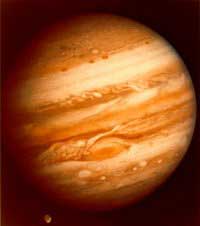
Voyager 1 took this photo of the planet Jupiter on January 24, while still more than 25 million miles (40 million kilometres) away.
Voyager 1 flew by in March 1979 followed by Voyager 2 in July of the same year. The Voyagers vastly improved our understanding of the Galilean moons and discovered Jupiter's rings. They also took the first close up images of the planet's atmosphere.
Ulysses flyby mission
In February 1992, Ulysses solar probe performed a flyby of Jupiter at a distance of 900,000 km (6.3 Jovian radii). The flyby was required to attain a polar orbit around the Sun. The probe conducted studies on Jupiter's magnetosphere. Since there are no cameras onboard the probe, no images were taken. In February 2004, the probe came again in the vicinity of Jupiter. This time distance was much greater, about 240 million km.
Galileo mission
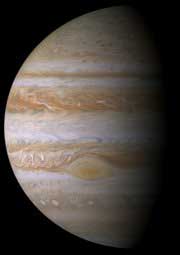
Jupiter as seen by the space probe Cassini. This is the most detailed global color portrait of Jupiter ever assembled.
So far the only spacecraft to orbit Jupiter is the Galileo orbiter, which went into orbit around Jupiter in December 7, 1995. It orbited the planet for over seven years and conducted multiple flybys of all of the Galilean moons and Amalthea. The spacecraft also witnessed the impact of Comet Shoemaker-Levy 9 into Jupiter as it approached the planet in 1994, giving a unique vantage point for this spectacular event. However, the information gained about the Jovian system from the Galileo mission was limited by the failed deployment of its high-gain radio transmitting antenna.
An atmospheric probe was released from the spacecraft in July, 1995. The probe entered the planet's atmosphere in December 7, 1995. It parachuted through 150 km of the atmosphere, collecting data for 58 minutes, before being crushed by the extreme pressure to which it was subjected. It would have melted and vaporized shortly thereafter. The Galileo orbiter itself experienced a more rapid version of the same fate when it was deliberately steered into the planet on September 21, 2003 at a speed of over 50 km/s, in order to avoid any possibility of it crashing into and possibly contaminating Europa, one of the Jovian moons.
Cassini flyby mission
In 2000, the Cassini probe, en route to Saturn, flew by Jupiter and provided some of the highest-resolution images ever made of the planet.
Future probes
NASA is planning a mission to study Jupiter in detail from a polar orbit. Named Juno, the spacecraft is planned to launch by 2010.
After the discovery of a liquid ocean on Jupiter's moon Europa, there has been great interest to study the icy moons in detail. A mission proposed by NASA was dedicated to study them. The JIMO (Jupiter Icy Moons Orbiter) was expected to be launched sometime after 2012. However, the mission was deemed too ambitious and its funding was cancelled.
In 2007, Jupiter will also be briefly visited by the New Horizons probe, en route to Pluto.
Jupiter's moons
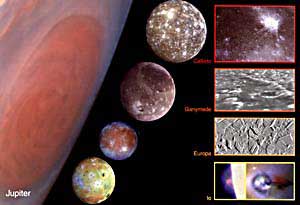
Jupiter's 4 Galilean moons, in a composite image comparing their sizes and the size of Jupiter (Great Red Spot visible). From the top they are: Callisto, Ganymede, Europa and Io.
Jupiter has at least 63 moons. For a complete listing of these moons, please see Jupiter's natural satellites. For a timeline of their discovery dates, see Timeline of natural satellites.
The four large moons, known as the "Galilean moons", are Io, Europa, Ganymede and Callisto.
Galilean moons
The orbits of Io, Europa, and Ganymede, the largest moon in the solar system, form a pattern known as a Laplace resonance; for every four orbits that Io makes around Jupiter, Europa makes exactly two orbits and Ganymede makes exactly one. This resonance causes the gravitational effects of the three moons to distort their orbits into elliptical shapes, since each moon receives an extra tug from its neighbors at the same point in every orbit it makes. Without this resonance, tidal forces would tend to circularize the moons' orbits over time.
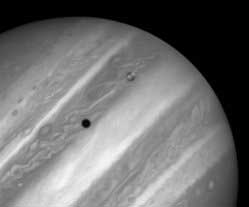
A picture of Jupiter and its moon Io taken by Hubble. The black spot is Io's shadow.
The tidal force from Jupiter, on the other hand, works to circularize their orbits. This constant tug of war causes regular flexing of the three moons' shapes, Jupiter's gravity stretches the moons more strongly during the portion of their orbits that are closest to it and allowing them to spring back to more spherical shapes when they're farther away. This flexing causes tidal heating of the three moons' cores. This is seen most dramatically in Io's extraordinary volcanic activity, and to a somewhat less dramatic extent in the geologically young surface of Europa indicating recent resurfacing.
Classification of Jupiter's moons
It used to be thought that Jupiter's moons were arranged neatly into four groups of four, but recent discoveries of many new small outer moons have complicated the division; there are now thought to be six main groups, although some are more distinct than others.

Europa, one of Jupiter's many moons.
- The inner group of four small moons all have diameters of less than 200 km, orbit at radii less than 200,000 km, and have orbital inclinations of less than half a degree.
- The four Galilean moons were all discovered by Galileo Galilei, orbit between 400,000 and 2,000,000 km, and include some of the largest moons in the solar system.
- Themisto is in a group of its own, orbiting halfway between the Galilean moons and the next group.
- The Himalia group is a tightly clustered group of moons with orbits around 11-12,000,000 km from Jupiter.
- Carpo is another isolated case; at the inner edge of the Ananke group, it revolves in the direct sense.
- The Ananke group is a group with rather indistinct borders, averaging 21,276,000 km from Jupiter with an average inclination of 149 degrees.
- The Carme group is a fairly distinct group that averages 23,404,000 km from Jupiter with an average inclination of 165 degrees.
- The Pasiphaë group is a dispersed and only vaguely distinct group that covers all the outermost moons.
It is thought that the groups of smaller moons may each have a common origin, perhaps as a larger moon or captured body that broke up into the existing moons of each group.
Trojan asteroids
In addition to its moons, Jupiter's gravitational field controls numerous asteroids which have settled into the Lagrangian points preceding and following Jupiter in its orbit around the sun. These are known as the Trojan asteroids, and are divided into Greek and Trojan "camps" to commemorate the Iliad. The first of these, 588 Achilles, was discovered by Max Wolf in 1906; since then hundreds more have been discovered. The largest is 624 Hektor.
Cometary impact
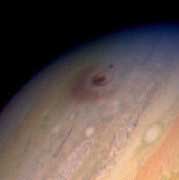
A Comet impacts on the surface of Jupiter. The dark clouds resulting from these impacts are larger than Earth itself.
During the period July 16 to July 22, 1994, over twenty fragments from the comet Shoemaker-Levy 9 hit Jupiter's southern hemisphere, providing the first direct observation of a collision between two solar system objects. It is thought that due to Jupiter's large mass and location near the inner solar system it receives the most frequent comet impacts of the solar system's planets.
Jupiter in fiction and film
- In H. P. Lovecraft's Cthulhu Mythos (1928–), Jupiter was the one-time home of the flying polyps.
- In Doctor Who (1963–), Jupiter is the setting for Nerva Beacon. A fictional space station that moniters its fictional new moon (Voga - The Planet of Gold) which once more brings the Cybermen into our Solar System.
- In the Star Trek universe (1966–), Jupiter is home to Jupiter Station.
- Jupiter is the setting of Stanley Kubrick's classic film 2001: A Space Odyssey (1968), although the novel of the same name by Sir Arthur C. Clarke is set in the Saturnian system instead. In both the book and the film of the sequel, 2010: Odyssey Two (1984), fictional technology converts Jupiter into a star by increasing the density of its core.
- In Piers Anthony's Bio of A Space Tyrant series (1983–2001), Jupiter is rendered into an analogue of North America. The moons are the Caribbean (and possibly Central America as well), Jupiter itself is inhabited by floating cities in its atmosphere to represent the United States, and the Red Spot represents Mexico.
- The novels of Kim Stanley Robinson, including The Memory of Whiteness (1985), Green Mars (1993) and Blue Mars (1996) depict numerous ideas about the future colonization of Jupiter, although they focus more on the moons than on the planet itself.
- Both Arthur C. Clarke's novella A Meeting with Medusa (1988) and his novel 2010 depict journeys into the depths of Jupiter's atmosphere, where vast, city-sized floating life-forms have evolved.
- In the anime Gunbuster (1988), Jupiter is used to create the black hole bomb, a massive weapon larger than a small planet, and capable of destroying part of a galaxy. (In fact, a Jupiter-mass black hole would be barely 6 m across, and no more of a threat to the Galaxy than it is right now)
- The role-playing game Jovian Chronicles (1992) features a solar nation, the Jovian Confederacy, in a series of space colony cylinders called "Gray Viarium" colonies around Jupiter.
- The plot of the anime Martian Successor Nadesico (1996) revolves around a mysterious invasion force based on Jupiter, named the "Jovian Lizards", or simply the "Jovians", and the attempts of the earth's forces, and specifically the ship Nadesico, to subdue this invasion.
- Jupiter is an important location in The Night's Dawn Trilogy (1996–1999) by Peter F. Hamilton. This is where the first Bitek habitat was germinated and Edenism began.
- In the anime Cowboy Bebop (1998), various episodes take place on Jupiter's moons. In, "Mushroom Samba",the crew was on its way to Europa, but had to land on Io. The two part "Jupiter Jazz" episodes takes part on Callisto, and "Ganymede Elegy", obviously takes place on Ganymede.
- The PlayStation 2 video game Zone of the Enders (2001) takes place in a colony orbiting Jupiter. Zone of the Enders: The 2nd Runner begins on the moon Callisto.
- Ben Bova's novel Jupiter (2001) also features a journey into Jupiter's clouds and the discovery of life there.
- In the massively multiplayer online role-playing game (MMORPG) Earth and Beyond (2002), the Jupiter system is colonized by the explorer race of the Jenquai. Jove City rests in orbit around Jupiter, and was the second most populated station in the known galaxy before being devastated by the Progen Warriors.
Space Odyssey Series
In Arthur C. Clarke's Space Odyssey Series, Jupiter was renamed Lucifer after its transformation into Earth's second sun. William Milton Cooper's book Behold A Pale Horse described a secret illuminati plan to detonate the planet by means of the Cassini-Huygens space probe.
Jupiter and Internet conspiracists
Although the theory of the intentional detonation of Jupiter predates the internet, the web spawned at least one theory of its own. On October 19, 2003 a black spot was photographed on Jupiter by Belgian astronomer Olivier Meeckers [3]. Although not an unusual occurrence, this one caught the fancy of some science fiction fans and conspiracy theorists, who went as far as speculating that the spot was evidence of nuclear activity on Jupiter, caused by Galileo's plunge into the planet a month prior [4]. Galileo carried about 15.6 kg [5] of plutonium-238 as its power source, in the form of 144 pellets of plutonium dioxide, a ceramic [6] [7]. The individual pellets (which would be expected to separate during entry) initially contained about 108 grams of 238Pu each (about 10% would have decayed away by the time Galileo entered Jupiter), and are short of the required critical mass by a factor of about 100 [8].
See also
Jupiter in astrology
Jupiter in Mythology
Jupiter - A Travelers' Guide to the Planets
References
Bagenal, F. & Dowling, T. E. & McKinnon, W. B. (Eds.). (2004). Jupiter: The planet, satellites, and magnetosphere. Cambridge: Cambridge University Press.
^ Clarke, Arthur C. (1989) 2061: Odyssey Three, Del Rey. ISBN 0345358791
(moon navigator) | Jupiter | Metis | ...
Jupiter's natural satellites
Inner satellites | Galilean moons: Io, Europa, Ganymede, and Callisto | Themisto | Himalia group | Carpo | S/2003 J 12 | Ananke group | Carme group | Pasiphaë group | S/2003 J 2
Our Solar System
Sun | Mercury | Venus | Earth (Moon) | Mars | Asteroid belt
Jupiter | Saturn | Uranus | Neptune | Pluto (Charon) | Kuiper belt | Scattered disc | Oort cloud
See also astronomical objects and the solar system's list of objects, sorted by radius or mass
Retrieved from "http://en.wikipedia.org/"
All text is available under the terms of the GNU Free Documentation License

